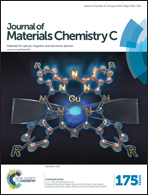Effect of cyano-substitution in distyrylbenzene derivatives on their fluorescence and electroluminescence properties†
Abstract
Efficient organic electroluminescent materials with both high solid-state fluorescence efficiency and high excitons usage efficiency for use in organic light-emitting diodes (OLEDs) are relatively rare. We report two isomeric-phenylethylene compounds with different positions and spatial orientation of the –CN substituent on the vinylene groups, namely α-CN-APV and β-CN-APV. The synthesis, characterization, crystal structure, optical, electrochemical, thermal, and electroluminescence (EL) properties of the two compounds are discussed in detail. The crystal structure of the β-CN-APV shows tight solid-state organization because of two, oppositely pointed, vertically aligned, hydrogen bonds between the two cyano groups and the two vinylene hydrogens (CN⋯H–C![[double bond, length as m-dash]](https://www.rsc.org/images/entities/char_e001.gif) C), while the α-CN-APV showed more flexible molecular structure with absence of vinylene hydrogen intermolecular interactions in the crystal. Such tight intermolecular stacking of β-CN-APV ensures the high solid-state fluorescence quantum efficiency. Both the compounds exhibit hybrid local and charge transfer (HLCT) excited states, which facilitate the population of singlet excitons through the reverse intersystem crossing (RISC) process from the high lying triplet states. Experimental and theoretical investigation indicated that the β-CN-APV, when compared to the α-CN-APV, showed higher solid-state fluorescence quantum efficiency and also higher excitons usage efficiency, which eventually provided much higher external quantum efficiency and brightness in the corresponding EL devices.
C), while the α-CN-APV showed more flexible molecular structure with absence of vinylene hydrogen intermolecular interactions in the crystal. Such tight intermolecular stacking of β-CN-APV ensures the high solid-state fluorescence quantum efficiency. Both the compounds exhibit hybrid local and charge transfer (HLCT) excited states, which facilitate the population of singlet excitons through the reverse intersystem crossing (RISC) process from the high lying triplet states. Experimental and theoretical investigation indicated that the β-CN-APV, when compared to the α-CN-APV, showed higher solid-state fluorescence quantum efficiency and also higher excitons usage efficiency, which eventually provided much higher external quantum efficiency and brightness in the corresponding EL devices.


 Please wait while we load your content...
Please wait while we load your content...